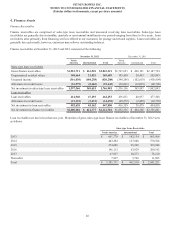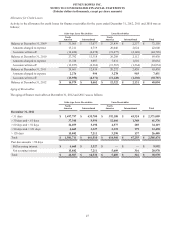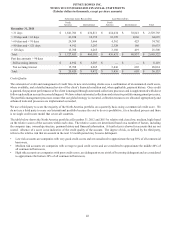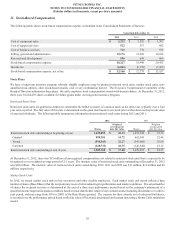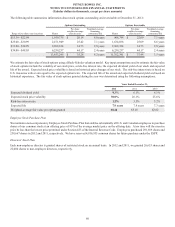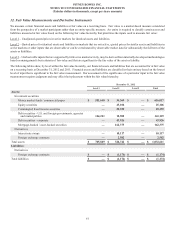Pitney Bowes 2012 Annual Report Download - page 74
Download and view the complete annual report
Please find page 74 of the 2012 Pitney Bowes annual report below. You can navigate through the pages in the report by either clicking on the pages listed below, or by using the keyword search tool below to find specific information within the annual report.
PITNEY BOWES INC.
NOTES TO CONSOLIDATED FINANCIAL STATEMENTS
(Tabular dollars in thousands, except per share amounts)
56
Uncertain Tax Positions
A reconciliation of the amount of unrecognized tax benefits is as follows:
2012 2011 2010
Balance at beginning of year $ 198,635 $ 531,790 $ 515,565
Increases from prior period positions 11,811 67,065 17,775
Decreases from prior period positions (17,985)(140,107) (27,669)
Increases from current period positions 28,255 28,686 43,804
Decreases from current period positions —— (8,689)
Decreases relating to settlements with tax authorities (1,948)(18,204) (1,434)
Reductions from lapse of applicable statute of limitations (71,863)(270,595) (7,562)
Balance at end of year $ 146,905 $ 198,635 $ 531,790
The amount of the unrecognized tax benefits at December 31, 2012, 2011 and 2010 that would affect the effective tax rate if recognized
was $127 million, $160 million and $249 million, respectively.
On a regular basis, we conclude tax return examinations, statutes of limitations expire, and court decisions interpret tax law. We regularly
assess tax uncertainties in light of these developments. As a result, it is reasonably possible that the amount of our unrecognized tax
benefits will decrease in the next 12 months, and we expect this change could be up to 10% of our unrecognized tax benefits. We recognize
interest and penalties related to uncertain tax positions in our provision for income taxes or discontinued operations as appropriate. During
the years ended December 31, 2012, 2011 and 2010, we recorded interest and penalties of $(28) million, $(83) million and $15 million,
respectively, primarily in discontinued operations. We had $11 million and $67 million accrued for the payment of interest and penalties
at December 31, 2012 and 2011, respectively.
Other Tax Matters
As is the case with other large corporations, our tax returns are examined each year by tax authorities in the U.S., other countries and
local jurisdictions in which we have operations. Except for issues arising out of certain partnership investments, the IRS examinations
of tax years prior to 2009 are closed to audit. Other than the pending application of legal principles to specific issues arising in earlier
years, only post-2007 Canadian tax years are subject to examination. Other significant tax filings subject to examination include various
post-2004 U.S. state and local, post-2007 German, and post-2008 French and U.K. tax filings. We have other less significant tax filings
currently under examination or subject to examination.
We regularly assess the likelihood of tax adjustments in each of the tax jurisdictions in which we have operations and account for the
related financial statement implications. We believe we have established tax reserves that are appropriate given the possibility of tax
adjustments. However, determining the appropriate level of tax reserves requires judgment regarding the uncertain application of tax
law and the possibility of tax adjustments. Future changes in tax reserve requirements could have a material impact, positive or negative,
on our results of operations, financial position and cash flows.
On August 27, 2012, the Third Circuit Court of Appeals overturned a prior Tax Court decision and ruled in favor of the IRS and adverse
to the Historic Boardwalk Hall LLC, a partnership in which we had made an investment in the year 2000. The decision has been appealed
and, therefore, the judgment is not yet final. Based on our partnership contractual relationship, we do not expect this matter to have a
material effect on our results of operations.
9. Noncontrolling Interests (Preferred Stockholders’ Equity in Subsidiaries)
Pitney Bowes International Holdings, Inc. (PBIH), a subsidiary, has 300,000 shares, or $300 million, of outstanding perpetual voting
preferred stock (the Preferred Stock) held by certain institutional investors. The holders of the Preferred Stock are entitled as a group to
25% of the combined voting power of all classes of capital stock of PBIH. All outstanding common stock of PBIH, representing the
remaining 75% of the combined voting power of all classes of capital stock, is owned directly or indirectly by the company. The Preferred
Stock is entitled to cumulative dividends at a rate of 6.125% through 2016 after which it becomes callable and, if it remains outstanding,
will yield a dividend that increases by 50% every six months thereafter. No dividends were in arrears at December 31, 2012 or December 31,
2011. There was no change in the carrying value of noncontrolling interests during the years ended December 31, 2012 or 2011.


